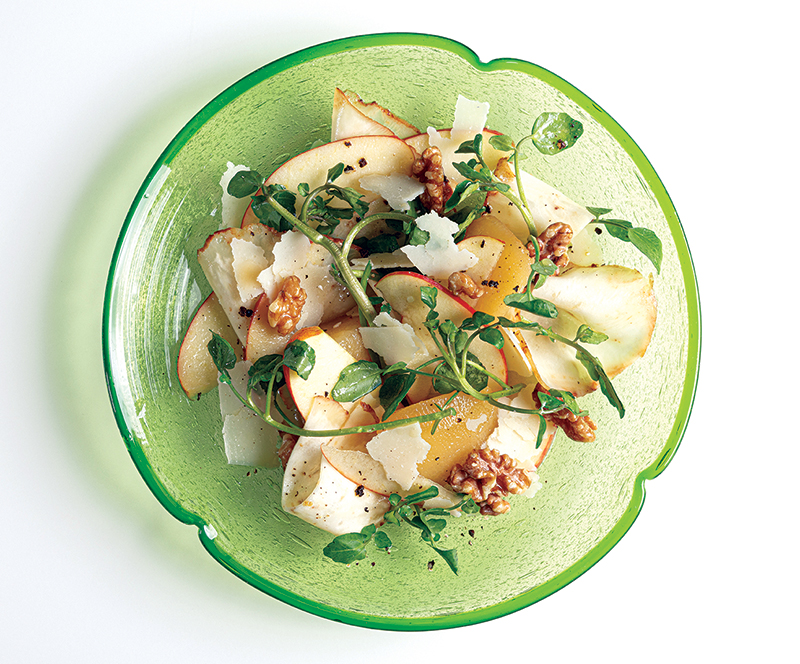
As a professional chef, I’m always looking for new dishes or ways to put a spin on familiar ones, especially those that I can share with home cooks. On a recent trip to the western Mediterranean coast, I enjoyed a refreshing cool-season salad built around familiar flavors but with less familiar ingredients prepared in unfamiliar ways. As a bonus, the salad is unusual and special enough to grace any holiday table and resilient enough to spend several hours on a buffet without suffering.
This dish is all about textures. It’s based around celery root, a wonderfully aromatic root vegetable too often neglected by home cooks, perhaps because of its rather unglamorous, even daunting, appearance. For this salad, almost all the preparation can be done several days ahead of serving (taking away a little of the stress on a busy day), and it even benefits with ten minutes or so of resting time after dressing and before serving. In addition, many of the ingredients can be adjusted to the needs of your own dining companions and their tastes (different fruits, nuts, cheeses, etc). I hope you will make this salad a part of your celebratory meals this season, bringing a little something new yet still comfortingly familiar to your holiday gatherings.
Celery Root, Apple, and Walnut Salad
This recipe, a symphony of textures and aromas, will generously feed four to six people as a salad course, although on a buffet it would mostly likely serve up to 15. Delicious on its own, it would make a substantial entrée salad with the addition of leftover roast chicken, ham, or turkey.
Begin by vigorously and thoroughly scrubbing a grapefruit-sized celery root, being careful to get into the little knobby crevices where the small roots protrude, and grit will imbed itself. I like to use a brush for this task, like the one I was gifted from Pryde’s Kitchen and Necessities several years ago (and although it looks like a potato, it scrubs all types of vegetables equally well). To achieve the resilient silken texture of the salad I experienced in Marseille, France, you must cook the celery root. The inspiring version I had in France was made with roasted celery root, but I found it easier and less time consuming to poach the celery root. To poach, place the root in a pot just slightly larger than it is, fill the pot with enough water to submerge the root (the root may float, in which case putting a small lid or plate on top of it to weigh it down will help it cook evenly.) Bring the water to a boil, then turn it down to a simmer and cook for 40 minutes to an hour (the time depends on the size, age, and water content of the celery root). It should be tender enough to pierce with a knife but still meet resistance—you do not want it to be mushy. Take the root out of the water and put it in the fridge to cool (for ease of slicing) while preparing the rest of the salad ingredients. (Tip: if allowed to cool overnight the job of slicing will be much easier.)
My inspiration salad was made with poached quince, a fruit that is a bit of a mystery to many Americans (read more about quince in my article here. If you are interested in preparing them, they are most reliably found at the Price Chopper in Roeland Park during the winter months). As an alternative, I suggest poached apples (3 apples total, but set 1 apple aside to use raw for crisp textural contrast). To poach the apples, peel 2 firm cooking apples (Gala was my choice for testing and they performed extremely well), then quarter and core them. Place them in a small pot with 2 cups of apple cider (or apple juice), ¼ cup apple cider vinegar, and 1 tablespoon honey. Bring it to a simmer and cook for about 15 minutes until the apples are just becoming tender. Remove the apple wedges to a bowl to cool. Raise the heat under the poaching liquid and reduce it to a syrupy ½ cup in volume. Pour the reduced syrup back over the apples until ready to serve. Lightly toast a generous handful of walnuts (pecans would be a lovely substitute) and reserve. My salad was garnished with sprigs of peppery watercress (watercress can be found in Asian and more adventurous grocery stores at this time of year). Arugula, equally refreshing but with a less toothsome texture, would make an admirable substitute. Whatever the green, rinse and dry it. Have a nice chunk of Parmigiano-Reggiano or Grana Padano cheese (although many different cheeses would be lovely here) and some extra-virgin olive oil at the ready. You now have everything assembled for your salad and the hard part is accomplished. This can all be done a day or two in advance, which frees you from prep on the day of serving.
When ready to serve, drain a few tablespoons of the apple cider syrup into a large wide bowl. Taste the syrup—it most likely needs more apple cider vinegar to balance the sweetness. Add a tablespoon or two of vinegar and a slightly larger volume of the olive oil. Season with a generous pinch of salt and a few grinds of black pepper. Whisk the dressing until creamy looking. Examine your celery root. If you see any bits that seem to have really thick skin or some dirty looking spots, trim that off. Otherwise, cut the celery root into two or three chunks, and with a vegetable peeler or the thin slicer attachment of a food processor (or a very sharp knife if you have some knife skills), slice the celery root as thinly as possible. When finished, using your hands or tongs, toss and massage the slices in the dressing so that every single surface is coated with vinaigrette. Thinly slice or cut into matchsticks the reserved raw apple and add it to the bowl. Add the poached apple wedges (cut in half if the apples were large), the walnuts, the cleaned watercress, and toss everything again to coat. Taste a few bites for seasoning, adjusting salt, pepper, or vinegar as needed. Shave in the cheese and toss lightly. Transfer everything to a serving platter and garnish with more shavings of cheese. Enjoy with friends and family, while adding a bit of Mediterranean flair to your holiday table.
Other Celeries
Unless you’re on some trendy food cleanse, you probably almost never think about celery. The plant itself is extremely versatile and plays many unseen or unmentioned roles in cuisines across the world. There are three forms of cultivated celery (Apium graveolens for plant geeks): the common stem celery which we see every day (variety dulce), root celery or celeriac (var. rapaceum), and leaf or soup celery (var. secalinum). Read on for ideas for using the lesser-known celery products.
 Soup/Leaf Celery
Soup/Leaf Celery
Mostly commonly found as “Chinese” celery in Asian groceries or farmers markets, this variety most resembles celery in the wild. The stalks of this celery are thinner than cultivated Western celery and are frequently crushed before cooking. Its delicious bitter-peppery qualities lend it to quick pickling and sautés. Let it be the star in a stir-fry with garlic, red pepper, and ginger, or allow its flavors to harmonize with other vegetables and serve over rice. It is the easiest variety for home gardeners to cultivate.
 Celeriac
Celeriac
AKA celery root, this intimidating knobby ball tastes wholly of celery and is wonderful both raw and cooked. Shaved paper thin it is delicious combined with lemon, raw mushrooms, cheese, and arugula in a salad, or try it shredded and dressed with mustard and mayo in the classic French remoulade. It’s also delicious as a roasted vegetable, mash, purée, or made into a soup. If the root ball has any green stems or leaves attached, don’t discard them. Although fibrous and generally inedible, they make a wonderfully aromatic addition to stock or broth.
 Celery Seed and Salt
Celery Seed and Salt
Celery seed, mostly harvested from soup celery or wild celery, conveys the aromas of celery to dishes without the distraction of celery fibers and crunch. Countless versions of potato salad would be impossible without it. Celery salt is simply whole celery seed ground with salt which makes for an instant addition of flavor when your soup or sauce needs a little something extra. Due to the presence of naturally occurring nitrites in celery and sea salt, many “naturally” cured meats are made possible with their addition. As for a good Bloody Mary—it would be impossible without it.


